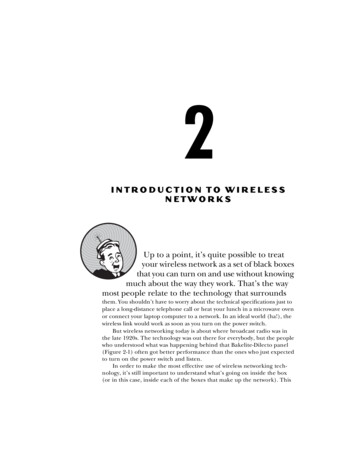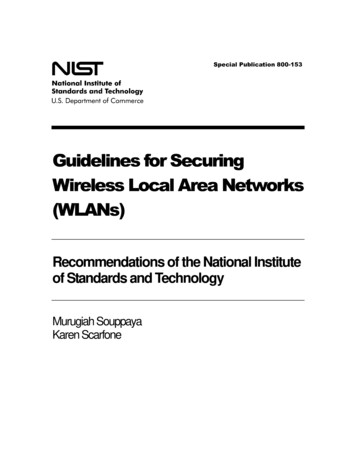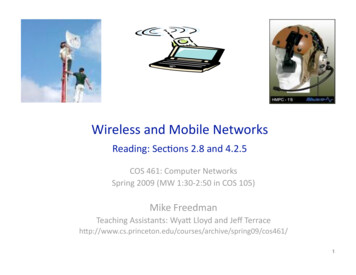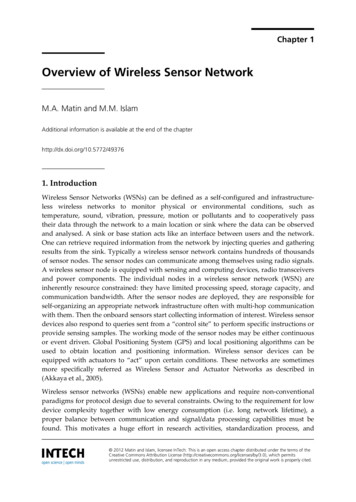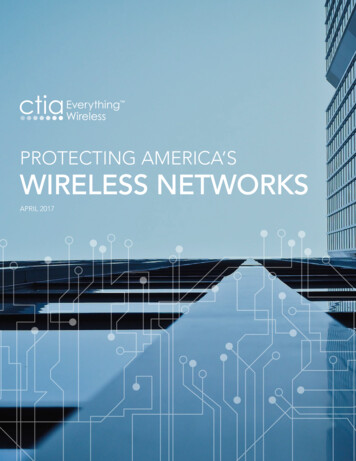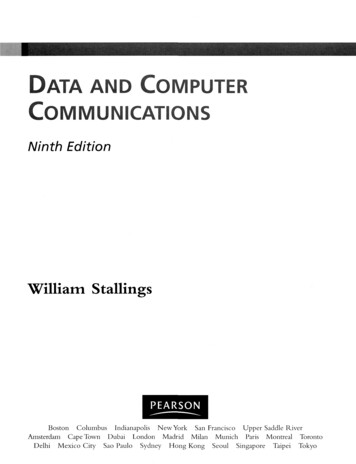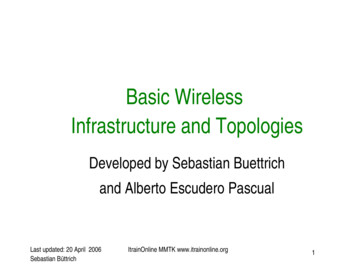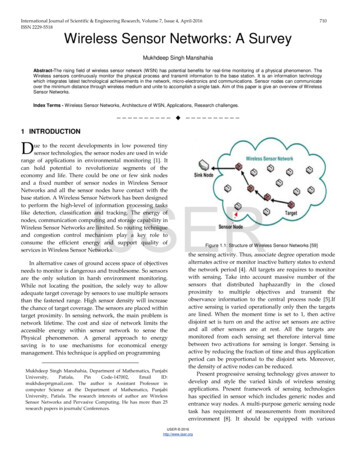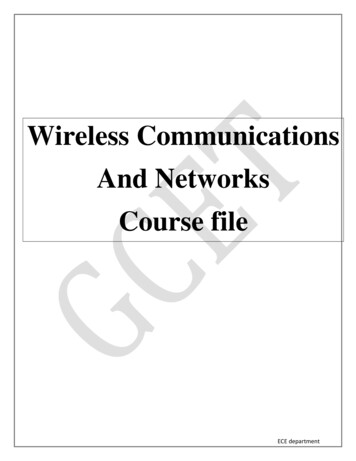
Transcription
Wireless CommunicationsAnd NetworksCourse fileECE department
ContentsCourses file Contents:1. Cover Page2. Syllabus copy3. Vision of the Department4. Mission of the Department5. PEOs and POs6. Course objectives and outcomes7. Brief note on the importance of the course and how it fits into the curriculum8. Prerequisites, if any9. Instructional Learning Outcomes10.Prerequisites, if any11.Course mapping with POs12.Class Time Table13.Individual Time Table14. Lecture schedule with methodology being used15.Detailed notes16.University Question papers of previous years17.Question Bank18. Assignment topics19.Unit wise Quiz questions and long answer questions20.Tutorial problems21.Known gaps, if any and inclusion of same in the lecture schedule22.Discussion topics, if any23.References, Journals, websites and E-links24. Quality measurement sheetsa) Course end surveyb) Teaching evaluation25. Student List26. Group-Wise students list for discussion topics.ECE department
1. Cover page:GEETHANJALI COLLEGE OF ENGINEERING AND TECHNOLOGYDEPARTMENT OF Electronics and Communication Engineering(Name of the Subject / Lab Course) : wireless Communications and Networks(JNTU CODE 58023)Programme : UGBranch: ECEVersion No : 01 , dated: 29/11/15Year: IV Year ECEDocument Number :GCET/ECE/58023 / 01Semester: IINo. of pages :Classification status (Unrestricted / Restricted )Distribution List : Dept Library / Dept office /concerned staffPrepared by :updated by :1) Name : Y.SIVARAMAKRISHNA1) Name : Mrs.Ramadevi2) Sign2) Sign::3) Design : Asst. Professor3) Design :Asst. Professor4) Date4) Date :29/11/2015: 29/11/2015Verified by :* For Q.C.only1) Name1) Name ::2) Sign :2) Sign :3) Design :3) Design :4) Date4) Date::ECE department
2. Syllabus:JAWAHARLAL NEHRU TECHNOLOGICAL UNIVERSITY HYDERABADIV Year B.Tech. ECE.II-SemT4 1*P0C4WIRELESS COMMUNCIATIONS AND NETWORKS(ELECTIVE – IV)UNIT IIntroduction to wireless communication systems: Evaluation of mobile radio communications, examples ofwireless communication systems, paging systems, cordless telephone systems, compression of various wirelesssystems.UNIT IIMobile wireless communication systems: second generation cellular networks, third generation wirelessnetworks, wireless in local loop, wireless local area networks, Bluetooth and personal area networks.UNIT IIICellular system design fundamentals: spectrum allocation, basic cellular system, frequency reuse, channelassignment strategies, handoff strategies, interference and system capacity, trucking and grade off service,improving coverage and capacity, cell splitting.UNIT IVMultiple access technique for warless communications: introduction to multiple accesses, FDMA, TDMA,spread spectrum multiple access, SDMA, packet radio, capacity of cellular systems.UNIT VWireless Networking: Differebce between wireless and fixed telephone networks, development of wirelessnetworks, fixed network transmission hierarchy, traffic routing in warless networks, wireless data services,common channel signaling.UNIT VIWireless WAN: mechanism to support at mobile environment, communication in the infrastructure , iIS-95CDMA forward channel, IS-95 CDMA risers channel, packet and frame formats in IS-95,IMT -20000, forwardchannel in W-CDMA and CDMA 2000, reverse channels in W-CDMA and CDMA -2000 GPRS and higherdata rates, short messaging service in GPRS mobile application protocols.UNIT VIIWireless land: Historical overviews of the land industry, evolution of the wan industry, wireless homenetworking IEEE 802.11 the PHY layer, Mac layer wireless ATM, Hyperlink, Hyper Lan-2ECE department
UNIT VIIIOrthogonal frequency division multiplexing: basic principles of orthogonality single versus multi channelsystems, OFDM block diagram, and its exokanatiion, OFDM signal mathematical representation.TEXT BOOKS:1.Wireless Communications, Principles, Practice – Theodore, S. Rappaport, PHI, 2nd Edn., 2002.2. Wireless Communication and Networking – William Stallings, PHI, 2003.REFERENCES :1. Wireless Digital Communications – Kamilo Feher, PHI, 1999.2. Principles of Wireless Networks – Kaveh Pah Laven and P. Krishna Murthy, Pearson Education, 2002.3. Wireless Communications – Andreaws F. Molisch, Wiley India, 2006.4. Introduction to Wireless and Mobile Systems – Dharma Prakash Agarwal, Qing-An Zeng, Thomson 2ndEdition, 2006.3. Vision of the Department:To impart quality technical education in Electronics and Communication Engineering emphasizinganalysis, design/synthesis and evaluation of hardware/embedded software using various Electronic DesignAutomation (EDA) tools with accent on creativity, innovation and research thereby producing competentengineers who can meet global challenges with societal commit4. Mission of the Department:i. To impart quality education in fundamentals ofbasic sciences, mathematics, electronics andcommunication engineering through innovative teaching-learning processes.ii. To facilitate Graduates define, design, and solve engineering problems in the field of Electronics andCommunication Engineering using various Electronic Design Automation (EDA) tools.iii. To encourage research culture among faculty and students thereby facilitating them to be creative andinnovative through constant interaction with R & D organizations and Industry.iv. To inculcate teamwork, imbibe leadership qualities, professional ethics and social responsibilities instudents and faculty.ECE department
5. Program Educational Objectives of B. Tech (ECE) Program:I.To prepare students with excellent comprehension of basic sciences, mathematics and engineeringsubjects facilitating them to gain employment or pursue postgraduate studies with an appreciation forlifelong learning.II.To train students with problem solving capabilities such as analysis and design with adequate practicalskills wherein they demonstrate creativity and innovation that would enable them to develop state of theart equipment and technologies of multidisciplinary nature for societal development.III.To inculcate positive attitude, professional ethics, effective communication and interpersonal skillswhich would facilitate them to succeed in the chosen profession exhibiting creativity and innovationthrough research and development both as team member and as well as leader.Program Outcomes of B.Tech ECE Program:1. An ability to apply knowledge of Mathematics, Science, and Engineering to solve complex engineeringproblems of Electronics and Communication Engineering systems.2. An ability to model, simulate and design Electronics and Communication Engineering systems, conductexperiments, as well as analyze and interpret data and prepare a report with conclusions.3. An ability to design an Electronics and Communication Engineering system, component, or process to meetdesired needs within the realistic constraints such as economic, environmental, social, political, ethical,health and safety, manufacturability and sustainability.4. An ability to function on multidisciplinary teams involving interpersonal skills.5. An ability to identify, formulate and solve engineering problems of multidisciplinary nature.6. An understanding of professional and ethical responsibilities involved in the practice of Electronics andCommunication Engineering profession.7. An ability to communicate effectively with a range of audience on complex engineering problems ofmultidisciplinary nature both in oral and written form.8. The broad education necessary to understand the impact of engineering solutions in a global, economic,environmental and societal context.9. Recognition of the need for, and an ability to engage in life-long learning and acquire the capability for thesame.ECE department
10. A knowledge of contemporary issues involved in the practice of Electronics and CommunicationEngineering profession11. An ability to use the techniques, skills and modern engineering tools necessary for engineering practice.12. An ability to use modern Electronic Design Automation (EDA) tools, software and electronic equipment toanalyze, synthesize and evaluate Electronics and Communication Engineering systems for multidisciplinarytasks.13. Apply engineering and project management principles to one's own work and also to manage projects ofmultidisciplinary nature.Mapping of Course with Programme Educational er PEO 1WCNII PEO 2PEO 3 6. Course objectives: To understand the examples of wireless communication systems, paging systems,cordless telephone systems. To study the different generations of mobile networks, WAN and PAN. To understand the concepts of basic cellular system, frequency reuse, channel assignmentstrategies, handoff strategies, interference. To understand the FDMA, TDMA, spread spectrum multiple access. To study the Wireless Networking: Difference between wireless and fixed telephonenetworks, development of wireless networks. To study the concepts mobile environment, communication in the infrastructure , iIS-95CDMA forward channel, IS-95 CDMA risers channel, packet and frame formats in IS95,IMT -20000. To understand the evolution of the WAN industry, wireless home networking IEEE 802.11 the PHYlayer. To understand the concepts of orthogonal frequency division multiplexing.ECE department
Outcomes of the subject:Students are Able to understand the examples of wireless communication systems, paging systems, cordlesstelephone systems. To understand the second generation cellular networks, third generation wireless networks, wireless inlocal loop, wireless local area networks, Bluetooth and personal area networks. Able to understand the concepts of spectrum allocation, basic cellular system, frequency reuse, channelassignment strategies, handoff strategies, interference, improving coverage and capacity, cell splitting. To understand various multiple accesses techniques: FDMA, TDMA, spread spectrum multiple access,SDMA. To understand the difference between wireless and fixed telephone networks, development of wirelessnetworks. Able to understand the communication in the infrastructure , iIS-95 CDMA forward channel, IS-95CDMA risers channel, packet and frame formats in IS-95,IMT -20000, forward channel in W-CDMA. Able to understand the Historical overviews of the land industry, evolution of the wan industry, wirelesshome networking IEEE 802.11 the physical layer, MAC layer wireless ATM. To understand the concepts of orthogonal frequency division multiplexing: basic principles oforthogonality single versus multi channel systems, OFDM block diagram.7. Brief note on the importance of the course and how it fits into the curriculum:This course use assigned readings, lectures, and homework to enable the students to:a. Ability to understand the fundamentals of antennas and wave propagation.b. Understand the basics of cordless telephone systems.c. Able to understand the concepts of wireless lan and Bluetooth technologies.d.Able to understand the concepts of frequency reuse, hand-off strategies and cell-splitting.e. Ability to understand the different multiple access techniques, differences between wireless and fixedtelephone systems, ATM and orthogonal frequency division multiplexing.ECE department
8. Prerequisites, if any:Students should be well-worst with the fundamentals of antennas and wave-propagation, various analogand digital modulation techniques and brief knowledge on cellular and mobile communications.9. Instructional Learning Outcomes:Outcomes:On successful completion of this subject, students will be able to:1. Understand examples of wireless communication systems, paging systems, cordlesstelephone systems.2. Understand the differences second generation cellular networks, third generation wireless networks,wireless in local loop, wireless local area networks, Bluetooth and personal area networks.3. Understand the concepts of spectrum allocation, basic cellular system, frequency reuse,assignment strategies, handoff strategies and interference.channel4. Difference between wireless and fixed telephone networks, development of wireless networks, fixednetwork transmission hierarchy, traffic routing in warless networks, wireless data services.10. Course mapping with PEOs and Pos:Course Mapping with PEO’s and PO’s:a) an ability to apply the knowledge of Mathematics, science and engineering inElectronics and communicationsb) an ability to Design & Conduct Experiments, as well as analyze & Interpret Data c) an ability to design a system, component, or process to meet desired needs with inrealistic constraints such as economic, environmental, social, political, ethical, healthand safety, manufacturability, and sustainability d) an ability to function on multidisciplinary teams ECE department
e) an ability to Identify, Formulate & Solve problems in the area of Electronics andCommunications Engineering f) an understanding of professional and ethical responsibilityg) an ability to communicate effectivelyh) the broad education necessary to understand the impact of engineering solutions in aglobal, economic, environmental, and societal context i) a recognition of the need for, and an ability to engage in life-long learning j) a knowledge of contemporary issues k) an ability to use the techniques, skills, and modern engineering tools necessary forengineering practice 1. Domain knowledge: Graduates will be able to synthesize mathematics, science,engineering fundamentals, laboratory and work-based experiences to formulate andsolve engineering problems in Electronics and Communication engineeringdomains and shall have proficiency in Computer-based engineering and the use ofcomputational tools.2. Professional Employment: Graduates will succeed in entry-level engineeringpositions within the core Electronics and Communication Engineering,computational or manufacturing firms in regional, national, or internationalindustries and with government agencies.3. Higher Degrees: Graduates will succeed in the pursuit of advanced degrees inEngineering or other fields where a solid foundation in mathematics, science, andengineering fundamentals is required.4. Engineering citizenship: Graduates will be prepared to communicate and workeffectively on team based engineering projects and will practice the ethics of theirprofession consistent with a sense of social responsibility.5. Lifelong Learning: Graduates will recognize the importance of, and have the skillsfor, continued independent learning to become experts in their chosen fields and tobroaden their professional knowledge.6. Research and Development: To undertake Research and Development works inthe areas of Electronics and Communication fields. Mapping of Course with Programme Educational ester PEO 1II PEO 2PEO 3 ECE department
10. Course mapping with PEOs and POs:*When the course outcome weightage is 40%, it will be given as moderately correlated (1).*When the course outcome weightage is 40%, it will be given as strongly correlated(2).POs1 2WCNWould be able tounderstand theconcepts ofMultiple AccessTechniques forWirelessCommunicationAble to understand 2thedifferentgenerationsofcellular networks,wireless local areanetworks,BluetoothWould be able to 2understandthebasiccellularsystem, frequencyreuse,channelassignmentstrategies, handoffstrategies,interferenceAble to understand 2the concepts of Would able to 2212ECE department
Difference betweenwireless and fixedtelephonenetworks,developmentofwireless networks,fixednetworktransmissionhierarchyAble to understand 1the Wireless WAN,CDMA 200021Able to understand 1the Wireless LAN,IEEE 802.11 thePhysical layer21Would be able to 2understandtheOrthogonalfrequency divisionmultiplexing21222211. Class time table:12. Individual Time Table:13. Lecture schedule with methodology being used:Programme : B.TechFaculty Name: Mr. Y.SIVARAMAKRISHNAYear & Sem: IV -II Sem.Asst. ProfessorBranch: ECEDept: ECESubject name: WCNECE department
S.NoTopics to be coveredNo. of lecturehrs requiredUNIT IIntroduction to wireless communication systems:1.1Introduction to wirelesscommunication systems2.evaluation of mobile radio1communications3.examples of wireless1communication systems4.paging systems, cordless1telephone systems5.compression of various1wireless systems6.1Tutorial classpolling-Token Passing7.1Black board/ OHP/ ProjectorBlack board and ProjectorBlack board and ProjectorBlack board and ProjectorBlack board and ProjectorBlack board and ProjectorBlack board and Projector7Mobile wireless communication systems,1.2.4.5.6.7.8.UNIT II3.Mobile wirelesscommunication systems:second generation cellularnetworksthird generation wirelessnetworks,wireless in local loop,wireless local areanetworksBluetooth and personalarea networksTutorial classSolving universityPapersAssignmentUNITIIICellular system design fundamentals1.Cellular system design1Black board and Projector1Black board and Projector1Black board and Projector1Black board and Projector1Black board and Projector11Black board18Black board1Black board and ProjectorECE department
fundamentals:,spectrum allocation, basiccellular system, frequencyreusechannel assignmentstrategies, handoffstrategiesinterference and systemcapacity, trucking andgrade off serviceImproving coverage andcapacity, cell splitting.2.3.4.5.1Black board and Projector1Black board and Projector1Black board and Projector1Black board and Projector6.117Multiple access technique for warless communications:Tutorial classOverviewBlack boardMultiple access techniquefor warless communicationsintroduction to multipleaccessesFDMA, TDMA1Black board and Projector1Black board and Projector1Black board and Projector1Black board and Projector1Black board and Projector6.spread spectrum multipleaccess, SDMAPacket radio, capacity ofcellular systems.Tutorial class1Black board and Projector7.Assignment1Black board and Projector8.Solving university Papers1Black board and Projector1.2.4.5.UNIT IV3.89.2.3.UNIT VWireless Networking:1.Wireless NetworkingDifference between wirelessand fixed telephone networksdevelopment of wirelessnetworks, fixed networktransmission hierarchy1Black board and Projector1Black board and Projector1Black board and ProjectorECE department
4.5.traffic routing in warlessnetworks, wireless dataservicescommon channel signaling1Black board and Projector1Black board and ProjectorTutorial class1Black board and ProjectorOther IEEE 802.11standards1Black board and Projector7Black board and Projector1Black board and Projector1Black board and Projector1Black board and Projector1Black board and Projector1Black board and Projector1Black board and ProjectorUNIT VIWireless WAN1.Wireless WAN: mechanismtosupport at mobile environment2.communication in theinfrastructure , iIS-95 CDMAforward channel3.IS-95 CDMA risers channel,packet and frame formats inIS-95,IMT -200004.Forward channel in W-CDMAand CDMA 2000, reversechannels in W-CDMA andCDMA -2000.5.GPRS and higher data rates,short messaging service inGPRS mobile applicationprotocols6.Tutorial class7.Assignment1Black board and Projector8.Solving university Papers1Black board and Projector8Wireless land:Wireless land:1Black board and Projector2.Historical overviews of theland industry,evolution of the wan industry,wireless home networkingIEEE 802.11 the PHY layer,Mac layer wireless1Black board and Projector1Black board and Projector1Black board and Projector3.4.UNIT VII1.ECE department
5.ATM, Hyperlink, Hyper Lan-21Black board and Projector6.Virtual private Networks1Black board and Projector7.Tutorial class1Black board and Projector7Orthogonal frequency division multiplexing:1.Orthogonal frequencydivision multiplexing:1Black board and Projector2.basic principles oforthogonality single versusmulti channel systems,OFDM block diagram, and itsexokanatiionOFDM signal mathematicalrepresentation.Overview of OFDM1Black board and Projector1Black board and Projector1Black board and Projector1Black board and Projector6.Tutorial class1Black board and Projector7.Assignment1Black board and Projector8.Solving university Papers1Black board and ProjectorTOTAL8604.5.UNIT VIII3.9.ECE department
Geethanjali College of Engineering & TechnologyCheeryal (v), Ranga Reddy (D) , Keesera (M), HyderabadWIRELESS COMMUNICATION AND NETWORKSLesson ScheduleProgramme: B.TechYear & Sem: IV -II Sem.Branch: ECES. No12DateFaculty Name: Mr. Y.SIVARAMAKRISHNAAsst. ProfessorDept: ECETopics to be coveredIntroduction to wireless communication systems:29/12/2014Introduction to wireless communication systemsevaluation of mobile radio communications30/12/20143No. of lecturehrs required11examples of wireless communication systems16/1/2015paging systems, cordless telephone systems17/1/2015compression of various wireless systems1612/1/2015Tutorial class1719/1/2015polling-Token Passing145UNIT I5/1/201578Mobile wireless communication systems,20/1/2015Mobile wireless communication systems:121/1/2015second generation cellular networks110.27/1/2015third generation wireless networks,111.28/1/2015wireless in local loop, wireless local area networks12/2/2015Bluetooth and personal area networks113.3/2/2015Tutorial class114.4/2/2015Solving university Papers115.9/2/2015Assignment112.UNIT II9.8ECE department
16Cellular system design fundamentalsCellular system design fundamentals:,10/2/2015111/2/2015spectrum allocation, basic cellular system, frequency reuse11816/2/2015channel assignment strategies, handoff strategies117/2/2015118/2/2015interference and system capacity, trucking and grade offserviceImproving coverage and capacity, cell splitting.23/2/2015Tutorial class124/2/2015Overview11920UNIT III17211722Multiple access technique for warless communications:25/2/2015Multiple access technique for warless communications12/3/2015introduction to multiple accesses1243/3/2015FDMA, TDMA1254/3/2015spread spectrum multiple access, SDMA19/3/2015Packet radio, capacity of cellular systems.110/3/2015Tutorial class12811/3/2015Assignment12916/3/2014Solving university Papers12627UNIT IV238Wireless Networking:17/3/2015Wireless Networking13118/3/2015Difference between wireless and fixed telephone networks13223/3/201513324/3/2015development of wireless networks, fixed networktransmission hierarchytraffic routing in warless networks, wireless data services3425/3/2015common channel signaling101/4/2015Tutorial class16/4/2015Other IEEE 802.11 standards13536UNIT V301ECE department
737Wireless s WAN: mechanism to support at mobile /2015Solving university Papers141UNIT VI42communication in the infrastructure , iIS-95 CDMA forwardchannelIS-95 CDMA risers channel, packet and frame formats in IS95,IMT -20000Forward channel in W-CDMA and CDMA 2000, reverse channelsin W-CDMA and CDMA -2000.GPRS and higher data rates, short messaging service in GPRSmobile application protocolsTutorial class15/4/20151111845Wireless lan:20/4/20154647120/4/2015Historical overviews of the lan industry,120/4/2015evolution of the wan industry, wireless home networking121/4/2015IEEE 802.11 the PHY layer, Mac layer wireless121/4/2015ATM, Hyperlink, Hyper Lan-215021/4/2015Virtual private Networks15122/4/2015Tutorial class14849UNIT VIIWireless lan:7Orthogonal frequency division multiplexing:22/4/2015Orthogonal frequency division multiplexing:15322/4/2015122/4/2015basic principles of orthogonality single versus multi channelsystems,OFDM block diagram, and its exokanatiion27/4/2015OFDM signal mathematical representation.128/4/2015Overview of OFDM1545556UNIT VIII52ECE department1
5728/4/2015Tutorial class15829/4/2015Assignment15929/4/2015Solving university Papers1TOTAL86060HOD – E.C.E. Dept.ECE department
14. Detailed notes:Unit-1Introduction to wireless communication systems1.1IntroductionCommunication is one of the integral parts of science that has always been a focus point forexchanging information among parties at locations physically apart. After its discovery, telephones havereplaced the telegrams and letters. Similarly, the term mobile' has completely revolutionized thecommunication by opening up innovative applications that are limited to one's imagination. Today, mobilecommunication has become the backbone of the society. All the mobile system technologies have improvedthe way of living. Its main plus point is that it has privileged a common mass of society. In this chapter, theevolution as well as the fundamental techniques of the mobile communication is discussed.1.2Evolution of Mobile Radio CommunicationsThe first wireline telephone system was introduced in the year 1877. Mobile communication systems asearly as 1934 were based on Amplitude Modulation (AM) schemes and only certain public organizations maintainedsuch systems. With the demand for newer and better mobile radio communication systems during the World War IIand the development of Frequency Modulation (FM) technique by Edwin Armstrong, the mobile radiocommunication systems began to witness many new changes. Mobile telephone was introduced in the year 1946.However, during its initial three and a half decades it found very less market penetration owing to high costs andnumerous technological drawbacks. But with the development of the cellular concept in the 1960s at the BellLaboratories, mobile communications began to be a promising field of expanse which could serve wider populations.Initially, mobile communication was restricted to certain official users and the cellular concept was never evendreamt of being made commercially available. Moreover, even the growth in the cellular networks was very slow.However, with the development of newer and better technologies starting from the 1970s and with the mobile usersnow connected to the Public Switched Telephone Network (PSTN), there has been an astronomical growth in thecellular radio and the personal communication systems. Advanced Mobile Phone System (AMPS) was the first U.S.cellular telephone system and it was deployed in 1983. Wireless services have since then been experiencing a 50%per year growth rate. The number of cellular telephone users grew from 25000 in 1984 to around 3 billion in the year2007 and the demand rate is increasing day by day. A schematic of the subscribers is shown in Fig. 1.1ECE department
Figure 1.2: Basic mobile communication structure.1.3Present Day Mobile CommunicationSince the time of wireless telegraphy, radio communication has been used extensively. Our society has been looking foracquiring mobility in communication since then. Initially the mobile communication was limited between one pair of userson single channel pair. The range of mobility was de ned by the transmitter power, type of antenna used and thefrequency of operation. With the increase in the number of users, accommodating them within the limited availablefrequency spectrum became a major problem. To resolve this problem, the concept of cellular communication wasevolved. The present day cellular communication uses a basic unit called cell. Each cell consists of small hexagonal areawith a base station located at the center of the cell which communicates with the user. To accommodate multiple usersTime Division multiple Access (TDMA), Code Division Multiple Access (CDMA), Frequency Division Multiple Access(FDMA) and their hybrids are used. Numerous mobile radio standards have been deployed at various places such asAMPS, PACS, GSM, NTT, PHS and IS-95, each utilizing different set of frequencies and allocating differentnumber of users and channels.ECE department
Figure 1.3: The basic radio transmission techniques: (a) simplex, (b) half duplex and (c) full duplex.1.4Fundamental TechniquesBy definition, mobile radio terminal means any radio terminal that could be moved during its operation. Dependingon the radio channel, there can be three different types of mobile communication. In general, however, a MobileStation (MS) or subscriber unit communicates to a fixed Base Station (BS) which in turn communicates to thedesired user at the other end. The MS consists of transceiver, control circuitry, duplexer and an antenna while theBS consists of transceiver and channel multiplexer along with antennas mounted on the tower. The BS are alsolinked to a power source for the transmission of the radio signals for communication and are connected to a fixedbackbone network. Figure 1.2 shows a basic mobile communication with low power transmitters/receivers at the BS,the MS and also the Mobile Switching Center (MSC). The MSC is sometimes also called Mobile Tele-phoneSwitching Office (MTSO). The radio signals emitted by the BS decay as the signals travel away from it. A minimumamount of signal strength is needed in order to be detected by the mobile stations or mobile sets which are thehand-held personal units (portables) or those installed in the vehicles (mobiles). The region over which the signalstrength lies above such a threshold value is known as the coverage area of a BS. The xed backbone network is aECE department
wired network that links all the base stations and also the landline and other telephone networks through wires.1.4.1Radio Transmission TechniquesBased on the type of channels being utilized, mobile radio transmission systems may be classified as the followingthree categories which is also shown in Fig. 1.3:Simplex System: Simplex systems utilize simplex channels i.e., the communication is unidirectional. Thefirst user can communicate with the second user. However, the second user cannot communicate withthe first user. One example of such a system is a pager.Half Duplex System: Half duplex radio systems that use half duplex radio channels allow for nonsimultaneous bidirectional communication. The first user can communicate with the second user but thesecond user can commun
wireless in local loop, wireless local area networks, Bluetooth and personal area networks. 3. Understand the concepts of spectrum allocation, basic cellular system, frequency reuse, channel assignment strategies, handoff strategies and interference. 4. Difference between wireless and fixed telephone networ

